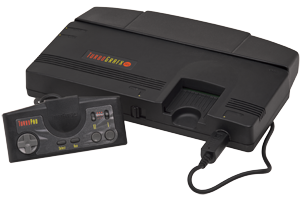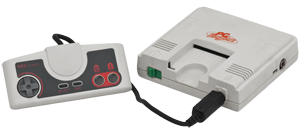|
|
Progress Continues
We've already had 21453 updates since Dolphin 5.0. Keep up with Dolphin's continuing progress through the Dolphin Blog: August, September, and October 2023 Progress Report. |
|
|
The Dolphin Emulator Wiki needs your help! Dolphin can play thousands of games, and changes are happening all the time. Help us keep up! Join in and help us make this the best resource for Dolphin. |
TurboGrafx-16
  | |
|---|---|
 TurboGrafx-16 TurboGrafx-16 PC Engine PC Engine | |
| Manufacturer | NEC Corporation |
| Generation | Fourth generation |
| Retail availability | JP October 30, 1987 NA August 29, 1989 |
| Discontinued | JP December 16, 1994 NA 1995 |
| Units sold | 10 million |
| Media | HuCard, CD-ROM (/w CD-ROM² add-on) |
| CPU | 7.16MHz Hudson Soft HuC6280 8-bit processor |
| Best-selling game | Bonk's Adventure |
| Successor | PC-FX (Wikipedia) |
TurboGrafx-16, fully titled as TurboGrafx-16 Entertainment SuperSystem and known in Japan as the PC Engine (PCエンジン Pī Shī Enjin), is a fourth generation video game console developed by Hudson Soft and NEC. In the United Kingdom, Telegames released a slightly altered version of the US model, known simply as the TurboGrafx, around 1990 in extremely limited quantities. Although there was no full-scale PAL region release of the system, imported PC Engine consoles were largely available in France and Benelux through major retailers thanks to the unlicensed importer Sodipeng (Société de Distribution de la PC Engine, a subsidiary of Guillemot International).
The TG-16 is a very small video game console, due primarily to a very efficient three-chip architecture and its use of "HuCards" (known in the US as TurboChips, roughly the size of a credit card) for game storage. The console featured a 16-bit custom video color encoder chip, 16-bit video display controller, and an 8-bit CPU with an integrated custom programmable sound generator. This three chip architecture allowed the TG-16 to have more sprites, a larger pallete, and better sound capabilities compared to its 8-bit competition at launch. However, its very early release in the fourth generation put it into a situation akin to the later Dreamcast: it was better than the third generation hardware, but inferior to its fourth generation competitors. While the TG-16 was comparable to other 16-bit consoles, it had very little RAM, no hardware parallax scrolling (a feature widely used to demonstrate the advantages of the 16bit era), and a single controller port.
The TurboGrafx was the first system to ever have a CD-Rom add-on, known as the TurboGrafx-CD in the US and as the Super CD-ROM² in Japan. In addition to having much more storage space compared to cards or cartridges, the add-on gave the console a much needed increase in RAM. A combination of the console and the CD-Rom addon was later released, known as the TurboDuo in the US and the PC Engine Duo in Japan.
The console initially competed well against the NES and Master System, especially in Japan, where it benefited from better marketing and the success of its CD-Rom add-on. However, the TG-16 was unable to compete against the SNES or the Genesis, reaching fourth place (behind even the NES) in both North America and Japan by 1991.
The TurboGrafx-16/PC Engine was discontinued in 1994 with the arrival of the Japan exclusive PC-FX.
There are no known global problems with TurboGrafx-16 titles on Dolphin.
Virtual Console Compatibility List (TurboGrafx-16)
Help complete the list!
- Click the icon
 to the right of the rating stars and put just a number 1 through 5 into the page. Use the compatibility guide below as a reference of what rating to use.
to the right of the rating stars and put just a number 1 through 5 into the page. Use the compatibility guide below as a reference of what rating to use. - When updating a rating, please make sure it's in accordance with the list of problems in the title's page.
| Region indicator | Region description |
|---|---|
| AU | Australia |
| CA | Canada (NTSC /w French translation) |
| EU | Europe, PAL/SECAM territories |
| JP | Japan and Asia (NTSC-J) |
| KO | Korea |
| NA | North America and NTSC territories |
| RU | Russia |